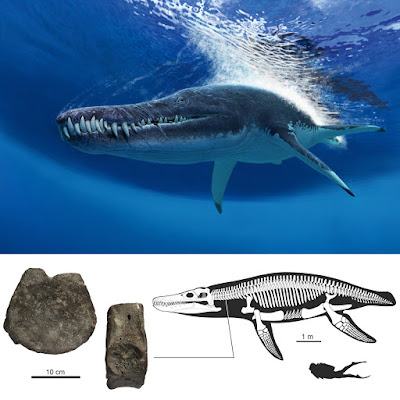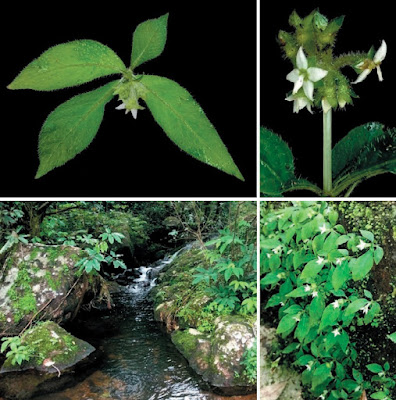[Most Recent Entries] [Calendar View]
Tuesday, March 15th, 2022
| Time | Event | ||||||||
| 3:14a | [Arachnida • 2022] Copa sakalava • A New Species of Copa (Araneae: Corinnidae: Castianeirinae) from Dry Forests in the north west of Madagascar
Abstract A new species of the castianeirine spider genus Copa Simon, 1885, is described from northwestern Mahamavo region in Madagascar. Copa sakalava sp. nov. (♂♀) is illustrated and diagnosed against continental Afrotropical congeners. Keywords: Araneae, Species discovery, taxonomy, Mahamavo, cryptic spider Copa sakalava sp. nov. Brogan L. Pett and Paul Bienvenu Rabemananjara. 2022. A New Species of Copa (Araneae: Corinnidae: Castianeirinae) from Dry Forests in the north west of Madagascar. Zootaxa. 5115(2); 281-287. DOI: 10.11646/zootaxa.5115.2.7 [2022-03-14] | ||||||||
| 3:42a | [Paleontology • 2020] A Gigantic Pliosaurid (Pliosauridae: Brachaucheninae) from the Cenomanian (Upper Cretaceous) of the Volga Region, Russia
Abstract Pliosaurid plesiosaurs were among the largest predators of Mesozoic marine ecosystems attaining giant sizes up to 10–11 m in length, near a quarter of which could be constituted by a massive head. The known Late Cretaceous pliosaurids are comparatively smaller than the stratigraphically older taxa and lack a suite of macropredaceous features, demonstrating a somewhat decline of the group members towards their extinction in the Turonian. However, the early Late Cretaceous (Cenomanian) record of pliosaurids is scarce and mostly represented by isolated teeth, thus hampering the recognition of diversity and disparity of pliosaurids in this time interval. Here we describe a very large isolated cervical centrum (19 cm in maximum diameter) belonging to a brachauchenine pliosaurid. The comparison with other pliosaurids indicates that the centrum belonged to one of the largest known pliosaurids, comparable in size to Kronosaurus queenslandicus, ‘Kronosaurus’ boyacensis and Sachicasaurus vitae from the Aptian–Albian of Australia and Barremian–Aptian of Colombia. This finding indicates that gigantic pliosaurids were also present in the Cenomanian. Thus, the previously inferred decrease in size of pliosaurids in the Late Cretaceous is likely a result of sampling bias, and, if present, it happened not earlier than in the late Cenomanian–Turonian, right before the extinction of the group. Keywords: Pliosauridae, Brachaucheninae, Gigantic pliosaurids, Late Cretaceous, Cenomanian Nikolay G. Zverkov and Evgeny M. Pervushov. 2020. A Gigantic Pliosaurid from the Cenomanian (Upper Cretaceous) of the Volga Region, Russia. Cretaceous Research. 110, 104419. DOI: 10.1016/j.cretres.2020.104419 Найденный на берегу Волги позвонок удлинил время существования гигантских плиозавров | ||||||||
| 10:01a | [Paleontology • 2022] Hutchemys walkerorum • A Softshell Turtle (Testudines: Trionychidae: Plastomeninae) from the uppermost Cretaceous (Maastrichtian) Hell Creek Formation, North Dakota, USA, with Implications for the Evolutionary Relationships of Plast
Abstract Plastomeninae, a clade of fossil turtles that has recently undergone significant revision, are currently known from the Late Cretaceous to the Eocene, with some genera known to survive the end-Cretaceous mass extinction (e.g., Hutchemys). Only one taxon survives past the Paleocene into the Eocene (Plastomenus thomasii). Despite the majority of Hutchemys being known from the Paleocene, only a single species is known from the Cretaceous. Here we describe Hutchemys walkerorum sp. nov. from the Upper Cretaceous of North Dakota. This new species can be assigned to Hutchemys by fading surface sculpturing of the carapace and distally split costals and distinguished from other Hutchemys species by several features, including aspects of the nuchal, costals, and placement of a carapacial constriction. The new species represents the second species of Hutchemys known from the Cretaceous, and potentially provides a direct anagenetic evolutionary lineage to H. tetanetron. It represents a third plastomenine evolutionary lineage present in the Hell Creek fauna of North Dakota, with Gilmoremeys lancensis and Helopanoplia distincta. A phylogenetic analysis recovers H. walkerorum among other Hutchemys species in a monophyletic group of derived plastomenines (Plastomenini clade nov.) and recovers a basal clade of trionychids (Kuhnemydinae subfam. nov.), along with Chitrainae subfam. nov., Cyclanorbinae, and Trionychinae. Trionychids likely originated in Asia during the middle-late Early Cretaceous, while plastomenines, an exclusively North American clade, evolved in, or prior to, the Campanian. Plastomenines were at their peak diversity in the Maastrichtian through the Paleocene, with complete extinction of the clade occurring by the Lutetian (Eocene). Hutchemys walkerorum sp. nov. Steven E. Jasinski, Andrew B. Heckert, Ciara Sailar, Asher J. Lichtig, Spencer G. Lucas and Peter Dodson. 2022. A Softshell Turtle (Testudines: Trionychidae: Plastomeninae) from the uppermost Cretaceous (Maastrichtian) Hell Creek Formation, North Dakota, USA, with Implications for the Evolutionary Relationships of Plastomenines and Other Trionychids. Cretaceous Research. In Press, 105172. DOI: 10.1016/j.cretres.2022.105172 | ||||||||
| 10:14a | [Ornithology • 2022] Fregetta lineata (Peale, 1848) is A Valid Extant Species Endemic to New Caledonia
Abstract We present evidence that confirms the streaked Fregetta lineata is a valid extant species that breeds on New Caledonia and endorse the vernacular name New Caledonian Storm Petrel. We review taxonomic deliberations over the historic five ‘Pealea’ streaked storm petrel specimens. Three belong to the recently rediscovered New Zealand Storm Petrel F. maoriana. We study six biometrics of the other two identical-looking specimens, one from Samoa, the other from the Marquesas Islands, a third ‘new’ specimen collected off Brisbane, and other Fregetta taxa. Results of Principal Component Analyses, Discriminant Analyses, and a review of phylogenetic relationships between Fregetta storm petrels, F. lineata and F. maoriana, lead us to conclude that the three specimens represent a single taxon, F. lineata. Furthermore, F. lineata is clearly separated from F. maoriana, White-bellied Storm Petrel F. grallaria and Black-bellied Storm Petrel F. tropica. We further conclude that storm petrels photographed at sea, off New Caledonia and in the Coral Sea, are F. lineata. We then redescribe F. lineata from at-sea observations, photographs taken at sea, and study of the three museum specimens. Criteria for in-hand and at-sea identification are presented. We report the first breeding record, from New Caledonia, a grounded fledgling presumably disoriented by onshore artificial lights. We explore likely breeding locations and conservation issues.
New Caledonian Storm Petrel Fregetta lineata Vincent Bretagnolle, Robert L. Flood, Sabrina Gaba and Hadoram Shirihai. 2022. Fregetta lineata (Peale, 1848) is A Valid Extant Species Endemic to New Caledonia. Bulletin of the British Ornithologists’ Club, 142(1):111-130. DOI: 10.25226/bboc.v142i1.2022.a6 | ||||||||
| 10:20a | [Botany • 2021] Argostemma quarantena (Rubiaceae) • A New Species from southern Western Ghats, India
Abstract Argostemma quarantena, a new rubiaceous species from Vagamon Hills of southern Western Ghats, India is described and illustrated here. The species shows similarities with two south Indian endemics, A. anupama and A. courtallense, but differs in many qualitative attributes. The present status of genus Argostemma in India is briefly discussed. An artificial key for the identification of Argostemma in Western Ghats is also provided. Keywords: Argostemmateae, Epilithic, Kottayam, Vagamon Hills
Argostemma quarantena Balan & Robi, sp. nov. Diagnosis: The new species is closely similar to A. anupama, but differs in it stem (suberect, terete stem vs erect, quadrangular stem), stipules (1.5–2.0 mm long, deltate stipules vs c. 1 mm long, ovate stipules), leaves (obovate-oblanceolate, densely strigose lamina with 6–10 pairs veins vs ovate-lanceolate, scabrous lamina with 4–6 pairs veins), length and form of umbel (c. 1.5 cm long, congested umbel vs 2.5–3.5 cm long, lax umbel), pedicels (2–3 mm long, stout, hirsute pedicels vs 8–10 mm, slender, pubescent pedicels), calyx lobes ( 2.5 mm long vs 4.0 mm long), corolla lobes (4.5 mm long, triangular vs 5.5–6.0 mm long, lanceolate) and anther filaments (not twisted vs twisted). It also shows similarities with A. courtallense, but differs mainly by its stipules (1.5–2.0 mm long, deltate stipules vs 7–8 mm long, ovate stipules), shape and indumentum of leaves (anisophyllous leaves with obovate-oblanceolate and densely strigose lamina vs isophyllous leaves with ovate-orbicular and sparsely pubescent lamina), number of lateral veins (6–10 pairs vs 4–7 pairs lateral veins), umbel (c. 2 cm long, congested umbel vs 4–8 cm long, lax umbel), corolla lobes (4–4.5 mm long vs 7–8 mm long) and anthers (ca 1.5 mm long, white anthers vs ca 3 mm long, yellow anthers). (Table 1). Etymology: The specific epithet quarantena indicates the out-break of COVID-19 corona virus across the world in 2020. The term quarantena was used in 14th–15th century Venetian language for a forty-day isolation period. The new species was described during the 2020 quarantine period imposed to curb the spread of the COVID-19 virus. This species is a dedication to the lakhs of people including eminent botanists and scientists who have lost their lives due to the COVID-19 virus in the year 2020. Distribution and ecology: Argostemma quarantena is known only from its type locality at Vagamon Hills, South India. Vagamon hills are traversed by numerous perennial fast flowing streams which originated from evergreen forest patches and pseudosholas at 1000–1400 m elevations asl. This species is thriving on boulders beside such streams and shaded areas, growing with mosses and ferns. Anoop Puthuparampil Balan, Aloor Jose Robi and Nanu Sasidharan. 2021. Argostemma quarantena (Rubiaceae, Ruboideae), A New Species from southern Western Ghats, India. Webbia: Journal of Plant Taxonomy and Geography. 76(1); 47-52. DOI: 10.36253/jopt-9592 | ||||||||
| 10:22a | [Botany • 2013] Impatiens theuerkaufiana (Balsaminaceae) • A New Scapigerous Species from the Western Ghats, India
Abstract Impatiens theuerkaufiana, a new scapigerous species of Impatiens (Balsaminaceae) from Wayanad district, Kerala, India is described and illustrated. It differs from I. dendricola by having entire lateral sepals, a transversely elliptic, bilobed dorsal petal with wavy margins, a short straight spur less than 5 mm long, and tuberculate seeds; from I. agumbeana by having pendulous linear lanceolate leaves, shorter pedicels up to 3.5 cm long, non-auricled lateral united petals, and an ellipsoid capsule; and from I. stocksii by having long petioles of 5–8 cm, an elliptic lanceolate leaf lamina, long pedicels of 2.0–3.5 cm, and a pouch-like short spur. Keywords: Endemic species, Kerala, new species, Wayanad
Impatiens theuerkaufiana Ratheesh & Sivadasan, sp. nov. The new species resembles I. dendricola and I. agumbeana, but differs by having the lower sepal with a short spur up to5 mm long, the dorsal petal transversely elliptic, basally and distally bilobed, wavy-margined, the lateral unitedpetals non-auricled, and a tuberculate seed coat. It differs from I. agumbeana by having pendulous linear lanceolateleaves, white flowers with a short pedicel up to 3.5 cm long, and ellipsoid capsules; and from I. stocksii by having along petiole of 5–8 cm, an elliptic lanceolate leaf lamina, longer pedicels of 2.0–3.5 cm, and a pouch-like short spur. Eponymy:— The specific epithet is in honor of Mr. Wolfgang D. Theuerkauf, founder of the Gurukula Botanical Sanctuary, Alattil, North Wayanad, Kerala and an ardent naturalist and botanist who devoted his life for conservation of wild plants of Western Ghats, and creating awareness and imparting education on nature, natural resources, and conservation. M. K. Ratheesh Narayanan, Jayesh P. Joseph, N. Anil Kumar, M. Sivadasan and Ahmed H. Alfarhan. 2013. Impatiens theuerkaufiana (Balsaminaceae), A New Scapigerous Species from the Western Ghats, India. Phytotaxa. 83(1):54-60. DOI: 10.11646/phytotaxa.83.1.3 |
| << Previous Day |
2022/03/15 [Calendar] |
Next Day >> |

























